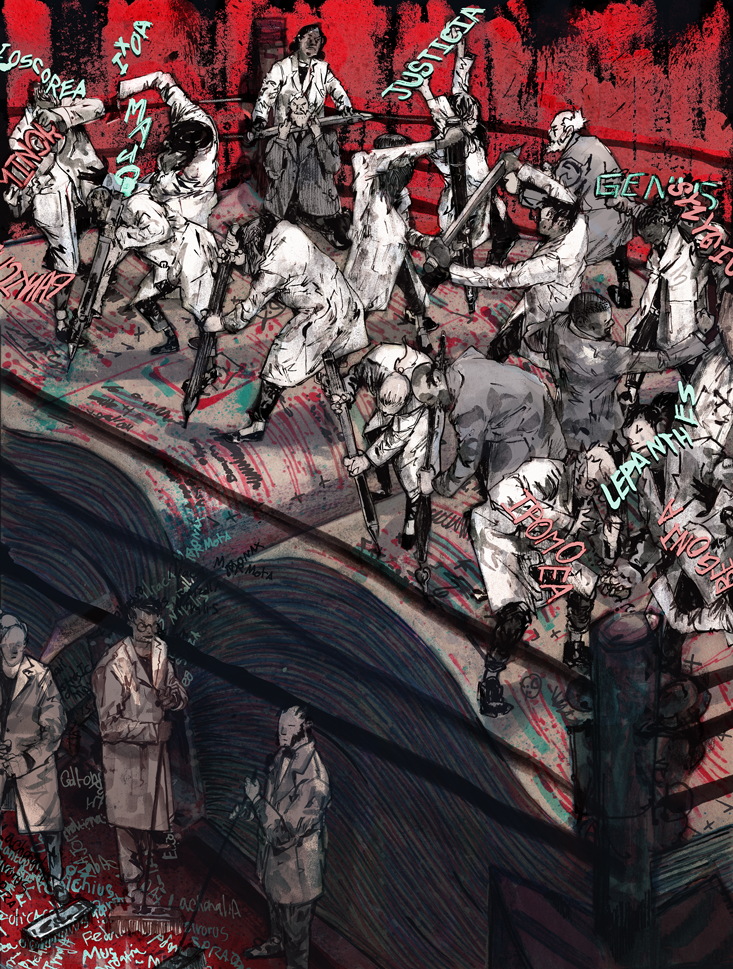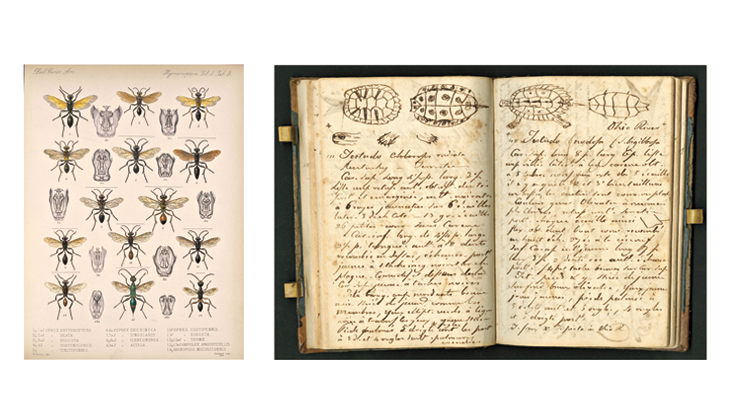To enjoy a story behind the story podcast of this article, just press the play button below.
Constantine Rafinesque had only been dead a few months when Asa Gray sat down to eulogize him for the American Journal of Science. The year was 1841, and Gray, soon to join both the American Academy and the Harvard faculty, was well on his way to becoming the most respected botanist of his generation. Grayia, a new genus of desert shrub, had just been named in his honor.
Rafinesque, on the other hand, was persona non grata. Described by peers as a “literary madman,” the Turkish-born polymath had died of cancer the previous fall. Among the many works he left behind were rambling discourses on zoology and geology; a catalog of Native American burial mounds; a new interpretation of the Hebrew Bible; a 5,400-line epic poem (with footnotes); and, last but not least, a lengthy series of studies on North American plants.
It was these last that had attracted Gray’s attention. That’s because scattered among Rafinesque’s botanical works were descriptions of over 6,000 new plant species, far more than any one person had managed to produce prior to that time—more, in fact, than anyone has produced since. It should have been an amazing accomplishment, and would have been, if only Rafinesque had been a decent botanist.
“Our task,” Gray began, “although necessary, as it appears to us, is not altogether pleasing …”
While the professor wanted to do “full justice” to Rafinesque’s life, he felt “obliged, at the same time, to protest against all of his later and one of his earlier botanical works … There can, we think, be but one opinion as to the consideration which is due to these new genera and species: They must be regarded as fictitious, and unworthy of the slightest notice.”
What can we say of his life? Nothing.
Through a lifetime of what historians would call a “nervous and appalling industry,” Rafinesque had somehow managed to produce thousands of pages of the worst work the field had ever seen. Full of errors and oversights, punctuated only by the occasional tirade, Rafinesque’s papers were case studies in sloppy work. His descriptions were so vague that readers had trouble attaching them to actual plants, and his talents for misidentification were legendary: Many of his “new” species were actually just well-known weeds.
Toward the end, Rafinesque’s “passion for establishing new genera and species,” Gray wrote, “appears to have become a complete monomania. This is the most charitable supposition we can entertain.” Now, in the months after his death, the scientific establishment had assessed his work and passed its judgment. Rafinesque’s “absurd” botanical legacy, Gray wrote, amounted to little more than a “curious mass of nonsense.”
Gray’s note wouldn’t be the last unkind obituary in the annals of taxonomy, nor would it be the worst. That’s because the rules dictating how taxonomists name and classify living things bind these scientists in a web of influence stretching far back into the 18th century. When an agent of chaos like Rafinesque enters the scene, that web can get sticky fast. In a field haunted by ghosts, someone has to reckon with the dead.
Taxonomy, the art and science of classifying life, really should be a civilized pursuit. It encourages solitude, concentration, care. It rewards a meticulous attention to detail. And while it might occasionally receive some good-natured ribbing from the popular culture—think of all those butterfly collectors stumbling around in Far Side cartoons—it continues to play a vital role at the foundations of modern biology.
It can come as a bit of a surprise, then, when that veneer of civilization cracks, and the field reveals itself to be one of the more contentious arenas in science, a place where arguments over names and classifications rage through the literature for decades. This is both a strength, as challenges to current classification keep the field dynamic and relevant, and an expression of its hardwired vulnerabilities.
For starters, there’s the problem of classification itself. Ever since Darwin gave us a framework for understanding common descent, the search has been on for a natural classification, an arrangement of nested groups, or taxa, that accurately reflects evolutionary relationships. In this scheme, a classification functions as an explicit evolutionary hypothesis—to say that five species form a genus is also to say that those five species share a unique common ancestor. Ditto for families and orders, right up through classes and kingdoms.
The obituarist referred to Walker’s work simply as the “evil.”
On another level, though, higher-order classifications are all a bit arbitrary. So long as all the members of a genus share a unique common ancestor and some unifying trait, the size of that genus—the number of related species lumped together under that name—is really up to the classifier. This has created generational fights between two different camps of taxonomists: splitters, who advocate for more and smaller groups, and lumpers, who like their groups big and inclusive.
And then there’s the problem of identifying species in the first place. While each of the many different textbook definitions seems straightforward enough in theory, discovering the actual boundaries of a species in nature can prove frustrating. Are subtle variations between two populations meaningful? Or are they just background noise? Working from a limited number of specimens or a dearth of genetic evidence, taxonomists often have to rely on intuition and experience to make that call. The resulting species definitions are provisional, and can be overturned by new evidence in the form of more specimens, novel genetic data, or broader geographic surveys.
To accommodate all this hypothesis testing, the field has committed itself to the principle of taxonomic freedom, the right of any individual to change any classification based on new evidence and his or her best judgment. The practical result is that classifications tend to fluctuate in ways that are both healthy and natural, and that ultimately lead to better agreement between those classifications and evolutionary history. It’s a messy process, but it seems to work.
To complicate things further, the Earth has an extraordinary abundance of biodiversity. In the years since Linnaeus introduced the modern system of classification and nomenclature, more than 250,000 species of plants and over 1.2 million species of animals have been described by naturalists. Each carries a unique, two-part name, or Latin binomial, that indicates both its genus group (e.g., Homo) and its species (sapiens). Keeping track of all these names and their shifting histories requires specialists to maintain a near-encyclopedic familiarity with the literature of their group.
Now imagine if two taxonomists, working in different languages, at different times, or in different parts of the world, independently describe the same species. Unaware of one another’s work, each would produce a different name for the same organism, only one of which can ultimately be correct. A similar problem occurs when taxonomists independently use the same name to describe two different species. To avoid the chaos that would result from either of these situations (known, respectively, as synonymy and homonymy), the field enshrines another principle, taxonomic stability, to serve as a counterbalance to taxonomic freedom. The idea is to find a classification that’s stable enough to be useful, but flexible enough to incorporate necessary changes.

This tension between freedom and stability was long ago formalized in two sets of official and binding rules: the International Code of Zoological Nomenclature (ICZN), which deals with animals, and the International Code of Nomenclature for algae, fungi, and plants (ICN). Periodically updated by committees of working taxonomists, these documents set out precise, legalistic frameworks for how to apply names both to species and to higher taxa. (The animal and plant codes operate independently, which means that an animal can share a scientific name with a plant, but not with another animal, and vice versa.)
Central to both, and to taxonomic stability itself, is the Principle of Priority, which states that the first valid scientific name applied to a group of animals is the valid name. If Linnaeus named a species in 1758, and that species is still recognized today, then Linnaeus’ name stands. Priority forms the backbone of biological nomenclature; without it, classification would degenerate, Babel-style, into a panoply of competing and incompatible systems. One consequence of all this is that taxonomists are constantly combing through the older literature to uncover the proper name for any given species. Another is that current classificatory changes come with a high potential for downstream influence.
And there’s the rub. In order to balance freedom with stability, the Codes generally remain silent on the question of quality: Any taxonomic proposal, no matter how outlandish, ill-informed, or incompetent, counts so long as it was published according to the barest of requirements set out in the Codes themselves. For the ICN, this means descriptions must be published in printed materials that are distributed to libraries and accessible to botanists. For the ICZN, which recently relaxed its requirements, descriptions can come in either publically accessible printed materials or Internet-based digital publications. In neither case do the Codes require peer review; if you can print it and you can distribute it, then you can describe pretty much whatever you want.
While this freedom opens up a valuable space for amateur contributions, it also creates a massive loophole for unscrupulous, incompetent, or fringe characters to wreak havoc. That’s because the Principle of Priority binds all taxonomists into a complicated network of interdependence; just because a species description is wrong, poorly conceived, or otherwise inadequate, doesn’t mean that it isn’t a recognized part of taxonomic history. Whereas in physics, say, “unified theories” scrawled on napkins and mailed in unmarked envelopes end up in trashcans, biologists, regardless of their own opinions, are bound to reckon with the legacy of anyone publishing a new name. Taxonomists are more than welcome to deal with (or “revise”) these incorrect names in print, but they can’t really ignore them.
And this, finally, is the context for Gray’s posthumous hatchet job. Rafinesque’s manic and reckless work on North American plants was more than just a curious sideshow in the history of American botany; it was a problem that other botanists had to solve. While Gray may have advocated for ignoring Rafinesque’s work wholesale, later taxonomists understood that kind of boycott as a violation, both in letter and in spirit, of the Codes of Nomenclature.
In fact, the extensive nature of Rafinesque’s interventions—and the complication that at least some of his new species were actually valid—meant that taxonomists would still be untangling his mess well into the 20th century. As E.D. Merrill, the Harvard botanist who set out to index and correct much of this work in the 1930s and ’40s, put it, “we would have been infinitely better off today had Rafinesque never written or published anything appertaining to the subject.”

More than twenty years too late for his scientific reputation, and after having done an amount of injury to entomology almost inconceivable in its immensity, Francis Walker has passed from among us.”
Walker’s two-page obituary, in the November 1874 issue of the Entomologist’s Monthly Magazine, sits between a short research note (“Emmelesia unifasciata three years in the pupa state”) and some words on the passing of William Lello (“He leaves a considerable collection of Lepidoptera …”). Written anonymously, it pulled no punches when it came to the late taxonomist’s legacy: The vast majority of the tens of thousands of new species he proposed were “objects of derision for all conscientious entomologists.” More than once, the obituarist referred to Walker’s work simply as the “evil.”
And yet, the man’s career had begun with promise. His first work, a well-regarded study of the tiny wasps known as chalcidids, had “marked an era in the study of its subject.” Despite considerable inherited wealth, he longed for a permanent position at one of Britain’s major collections. When that position failed to materialize, Walker, “in an unlucky moment,” instead took up the first in a long series of contract appointments cataloging insects for the British Museum.
This is where the trouble began. Moving from drawer to drawer through the collection, Walker took it upon himself to describe what he believed to be thousands of new species in virtually all major groups of insects, a task requiring skills far beyond what he, or anyone else, possessed. “The result,” the obituarist wrote, “was what might have been expected. The work was done mechanically: ‘new genera and species’ were erected in the most reckless manner …” Through a Rafinesquean combination of industry and incompetence, the humble Englishman had begun to single-handedly wreak havoc on the classification of the world’s insects.
The growth of so-called “vanity journals” has produced new avenues for what some have taken to calling “taxonomic vandalism.”
As Walker published more and more dubious names, in wider and wider groups, the entomological establishment grew ever louder in its condemnation. By the time he had exhausted most of the major insect orders, his once considerable “entomological reputation [had been] worn to shreds.” Walker, however, “appeared to be utterly indifferent to anything that could be hurled at him … In his social relations he was amiability itself …” When he died, at 65, the entomological community mourned the gentle soul who had walked the halls of the British Museum, but also let out a collective sigh of relief. “We earnestly hope,” the obituarist added, “that never again will it fall to us, nor to our successors in entomological journalism, to have to write such an obituary notice as this.”
But Walker’s name wouldn’t be the last to live in taxonomic infamy. In fact, his obituary seems downright tactful beside Claude Morley’s note, from 1913, on the death of Peter Cameron, an infamous describer of Central American insects.
“Peter Cameron is dead, as was announced by most of the halfpenny papers on December 4th. What can we say of his life? Nothing; for it concerns us in no way. What shall we say of his work? Much, for it is entirely ours, and will go down to posterity as probably the most prolific and chaotic output of any individual for many years past.”
Cameron, a Scottish amateur with a penchant for Central American insects, left a legacy that echoed for decades. Fifty years after his death, Richard Bohart, a taxonomist at the University of California Davis, would reiterate that the entomologist’s “work was careless, his descriptions poor, his locality data were often vague or omitted, his generic assignments were characteristically erroneous and contradictory, and he eschewed illustrations.” Despite all that, or perhaps because of it, Bohart wound up with the thankless task of sorting through Cameron’s North American contributions to a small group of wasps known as the Odynerini. Of the hundred or so names Cameron proposed within the group, almost all, Bohart found, were invalid.
Meanwhile, modern taxonomy has its own outliers. In 2006, over 50 scientists signed an open letter to the administration of the University of Utrecht protesting the work of one Dewanand Makhan, an amateur entomologist who frequently listed the university as his institutional affiliation. (Makhan was a contract employee at the university’s herbarium, and not a member of the academic staff; his publications now list a personal address.)
“For many years,” they wrote, “Dr. Makhan has been a growing threat to taxonomy and zoological nomenclature, publishing a large number of new genera and species in groups as wide ranging as beetles, spiders, and gastropods. These publications are uniformly poor in quality and scholarship.” A group of ant experts put it more bluntly: A 2007 publication by Makhan, they wrote, was “one of the most inadequate papers that has ever been produced in ant taxonomy.”
Makhan’s descriptions are notoriously short on detail. In place of clear scientific diagrams, he illustrates much of his work with blurry, out-of-focus photographs. Most frustrating to fellow entomologists, many of Makhan’s “new” species are instantly recognizable, at least to them, as already described insects. Despite numerous articles and blog posts on the so-called “Makhan problem,” new publications continue to appear, most in a small Australian journal without a traditional peer-review process. (As recently as last year, Makhan described a new species of waterbeetle, Desmopachria barackobamai—named, of course, for the 44th president of the United States.)
The story is a familiar one, but with a modern twist. That’s because the growth of so-called “vanity journals”—publications that look to all appearances like mainstream scientific outlets, but lack rigorous peer-review—has produced new avenues for what some have taken to calling “taxonomic vandalism.” As traditional boundaries between experts and amateurs dissolve in the face of digital publishing, more opportunities than ever exist for novel voices in science, journalism, and politics. Unfortunately, these opportunities come at a cost, as a growing tide of information challenges the discriminatory abilities of scientists and lay readers alike.
While discussions underway now could revise the Codes to include stricter controls on which publications count for classificatory changes, many taxonomists are wary of doing anything that might deter amateur contributions. With so many species left to discover, and with existential threats to biodiversity looming, they realize the field needs as much help as it can get.
In the struggle to balance its highest ideals with its unruliest practicioners, taxonomy teaches us an enduring lesson about science as a whole. While we like to think of that enterprise as an antidote to fallibility—a way of seeing that seeks, through meticulous care and relentless examination, to minimize our tendency toward error—it remains fundamentally, inescapably human. Somewhere in between is where real progress happens.
I was reminded of that when I found another obituary for Peter Cameron, this one from his hometown newspaper, the Glasgow Herald:
Much regret will be expressed in scientific circles throughout the world at the death of Mr. Peter Cameron, a well-known entomologist and a native of Glasgow. For fifteen years, Mr. Cameron lived as a recluse at New Mills, Derbyshire, but for the last three years he had lodged at the cottage of a labourer named Price … At the inquest, it was stated that Mr. Cameron’s only relative was a sister in Dresden. A doctor expressed the opinion that he had neglected himself, and the jury returned a verdict that death was due to alcoholism … Of late, his circumstances had not been very bright, which prompted a certain section of the Royal Society to get together a sum of money, which was given to him at intervals to meet his needs.
In 2014, a team of entomologists from the Universidad de Panamá and Spain’s Museo Nacional de Ciencias Naturales described a new species of gall wasp found in oak trees growing on the slopes of Panama’s Volcán Barú. Less than three millimeters long and with four finely veined wings, the species differs from its relatives in the United States by an additional antennal segment and a minor difference in the shape of its thorax.
Its name?
Callirhytis cameroni.
Ansel Payne is a writer and naturalist in Tuscaloosa, Alabama.
This article was originally published in our “Boundaries” issue in April, 2016.


























